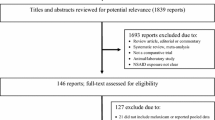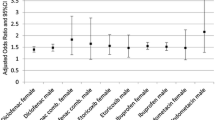Abstract
Certain non-steroidal anti-inflammatory drugs (NSAIDs) have been associated with an increased risk of myocardial infarction (MI), a risk linked to cyclo-oxygenase-2 inhibition. There are limited studies assessing the risk of MI associated with meloxicam, an increasingly popular drug with COX-2 inhibiting properties. A nested matched case–control study using The Health Improvement Network, a UK population-based database was conducted. NSAID users between 35 and 89 years of age with at least 1 year enrollment in the cohort were included. Incident MI cases were matched on age, sex, practice and event date with up to 4 controls. NSAID exposure was categorized as remote (between 60 days and 1 year), recent (between 1 and 60 days) or current relative to the event date. Current users were further classified as naproxen (negative control), diclofenac (positive control), meloxicam or other NSAID users. Multivariable conditional logistic regression was conducted to determine the risk of MI for each NSAID use categories compared with that of remote users. 9291 MI cases were matched with 30,676 controls. The cases had a higher prevalence of traditional cardiac risk factors, chronic kidney disease and inflammatory arthritis and cardioprotective drug utilization. The adjusted odds ratio of MI for current user compared to remote users were: meloxicam 1.38 (1.17–1.63), naproxen 1.12 (0.96–1.30) and diclofenac 1.37 (1.25–1.50). In this large population-based study, meloxicam increased the risk of MI by 38%. This study warrants cautious use of this increasingly popular drug.
Similar content being viewed by others
References
Bombardier C, Laine L, Reicin A, Shapiro D, Burgos-Vargas R, Davis B et al (2000) Comparison of upper gastrointestinal toxicity of rofecoxib and naproxen in patients with rheumatoid arthritis. VIGOR Study Group. N Engl J Med 343:1520–1528. doi:10.1056/NEJM200011233432103
Bresalier RS, Sandler RS, Quan H, Bolognese JA, Oxenius B, Horgan K et al (2005) Cardiovascular events associated with rofecoxib in a colorectal adenoma chemoprevention trial. N Engl J Med 352:1092–1102. doi:10.1056/NEJMoa050493
Nussmeier NA, Whelton AA, Brown MT, Langford RM, Hoeft A, Parlow JL et al (2005) Complications of the COX-2 inhibitors parecoxib and valdecoxib after cardiac surgery. N Engl J Med 352:1081–1091. doi:10.1056/NEJMoa050330
Solomon SD, McMurray JJ, Pfeffer MA, Wittes J, Fowler R, Finn P et al (2005) Cardiovascular risk associated with celecoxib in a clinical trial for colorectal adenoma prevention. N Engl J Med 352:1071–1080. doi:10.1056/NEJMoa050405
Cannon CP, Curtis SP, FitzGerald GA, Krum H, Kaur A, Bolognese JA et al (2006) Cardiovascular outcomes with etoricoxib and diclofenac in patients with osteoarthritis and rheumatoid arthritis in the Multinational Etoricoxib and Diclofenac Arthritis Long-term (MEDAL) programme: a randomised comparison. Lancet 368:1771–1781
Antman EM, Bennett JS, Daugherty A, Furberg C, Roberts H, Taubert KA et al (2007) Use of nonsteroidal antiinflammatory drugs: an update for clinicians: a scientific statement from the American Heart Association. Circulation 115:1634–1642. doi:10.1161/CIRCULATIONAHA.106.181424
Nussmeier NA, Whelton AA, Brown MT, Joshi GP, Langford RM, Singla NK et al (2006) Safety and efficacy of the cyclooxygenase-2 inhibitors parecoxib and valdecoxib after noncardiac surgery. Anesthesiology 104:518–526
Fitzgerald GA (2004) Coxibs and cardiovascular disease. N Engl J Med 351:1709–1711. doi:10.1056/NEJMp048288
Olsen AM, Fosbol EL, Lindhardsen J, Folke F, Charlot M, Selmer C et al (2012) Long-term cardiovascular risk of nonsteroidal anti-inflammatory drug use according to time passed after first-time myocardial infarction: a nationwide cohort study. Circulation 126:1955–1963. doi:10.1161/CIRCULATIONAHA.112.112607
Cryer B, Feldman M (1998) Cyclooxygenase-1 and cyclooxygenase-2 selectivity of widely used nonsteroidal anti-inflammatory drugs. Am J Med 104:413–421
Salvo F, Antoniazzi S, Duong M, Molimard M, Bazin F, Fourrier-Reglat A et al (2014) Cardiovascular events associated with the long-term use of NSAIDs: a review of randomized controlled trials and observational studies. Expert Opin Drug Saf 13:573–585. doi:10.1517/14740338.2014.907792
Trelle S, Reichenbach S, Wandel S, Hildebrand P, Tschannen B, Villiger PM et al (2011) Cardiovascular safety of non-steroidal anti-inflammatory drugs: network meta-analysis. BMJ 342:c7086. doi:10.1136/bmj.c7086
Varas-Lorenzo C, Riera-Guardia N, Calingaert B, Castellsague J, Salvo F, Nicotra F et al (2013) Myocardial infarction and individual nonsteroidal anti-inflammatory drugs meta-analysis of observational studies. Pharmacoepidemiol Drug Saf 22:559–570. doi:10.1002/pds.3437
Noble S, Balfour JA (1996) Meloxicam. Drugs 51:424–430 (discussion 431–432)
Distel M (1998) Meloxicam clinical data on a preferential cyclooxygenase-2 inhibitor. J Clin Rheumatol 4:s32–s39
Castellsague J, Riera-Guardia N, Calingaert B, Varas-Lorenzo C, Fourrier-Reglat A, Nicotra F et al (2012) Individual NSAIDs and upper gastrointestinal complications: a systematic review and meta-analysis of observational studies (the SOS project). Drug Saf 35:1127–1146. doi:10.2165/11633470-000000000-00000
Goei The HS, Lund B, Distel MR, Bluhmki E (1997) A double-blind, randomized trial to compare meloxicam 15 mg with diclofenac 100 mg in the treatment of osteoarthritis of the knee. Osteoarthr Cartil 5:283–288
Wojtulewski JA, Schattenkirchner M, Barcelo P, Le Loet X, Bevis PJ, Bluhmki E et al (1996) A 6-month double-blind trial to compare the efficacy and safety of meloxicam 7.5 mg daily and naproxen 750 mg daily in patients with rheumatoid arthritis. Br J Rheumatol 35(Suppl 1):22–28
Degner F, Sigmund R, Zeidler H (2000) Efficacy and tolerability of meloxicam in an observational, controlled cohort study in patients with rheumatic disease. Clin Ther 22:400–410
Dequeker J, Hawkey C, Kahan A, Steinbruck K, Alegre C, Baumelou E et al (1998) Improvement in gastrointestinal tolerability of the selective cyclooxygenase (COX)-2 inhibitor, meloxicam, compared with piroxicam: results of the Safety and Efficacy Large-scale Evaluation of COX-inhibiting Therapies (SELECT) trial in osteoarthritis. Br J Rheumatol 37:946–951
United States securities and exchange commission. http://www.sec.gov/Archives/edgar/data/1492426/000119312512129945/d272296d10k.htm http://www.sec.gov/Archives/edgar/data/1492426/000119312512129945/d272296d10k.htm:1-123
Chisholm J (1990) The read clinical classification. BMJ 300:1092
Lewis JD, Schinnar R, Bilker WB, Wang X, Strom BL (2007) Validation studies of the health improvement network (THIN) database for pharmacoepidemiology research. Pharmacoepidemiol Drug Saf 16:393–401. doi:10.1002/pds.1335
Garcia Rodriguez LA, Tacconelli S, Patrignani P (2008) Role of dose potency in the prediction of risk of myocardial infarction associated with nonsteroidal anti-inflammatory drugs in the general population. J Am Coll Cardiol 52:1628–1636. doi:10.1016/j.jacc.2008.08.041
Raghunathan T, Lepkowski J, Van Hoewyk J, Solenberger P (2001) A Multivariate technique for multiply imputing missing values using a sequence of regression models. Surv Methodol 27:85–95
Bhala N, Emberson J, Merhi A, Abramson S, Arber N et al (2013) Vascular and upper gastrointestinal effects of non-steroidal anti-inflammatory drugs: meta-analyses of individual participant data from randomised trials. Lancet 382:769–779. doi:10.1016/S0140-6736(13)60900-9
Helin-Salmivaara A, Virtanen A, Vesalainen R, Gronroos JM, Klaukka T, Idanpaan-Heikkila JE et al (2006) NSAID use and the risk of hospitalization for first myocardial infarction in the general population: a nationwide case–control study from Finland. Eur Heart J 27:1657–1663
Garcia Rodriguez LA, Varas-Lorenzo C, Maguire A, Gonzalez-Perez A (2004) Nonsteroidal antiinflammatory drugs and the risk of myocardial infarction in the general population. Circulation 109:3000–3006. doi:10.1161/01.CIR.0000132491.96623.04
van Staa TP, Rietbrock S, Setakis E, Leufkens HG (2008) Does the varied use of NSAIDs explain the differences in the risk of myocardial infarction? J Intern Med 264:481–492. doi:10.1111/j.1365-2796.2008.01991.x
Shau WY, Chen HC, Chen ST, Chou HW, Chang CH, Kuo CW et al (2012) Risk of new acute myocardial infarction hospitalization associated with use of oral and parenteral non-steroidal anti-inflammation drugs (NSAIDs): a case-crossover study of Taiwan’s National Health Insurance claims database and review of current evidence. BMC Cardiovasc Disord 12(1):4. doi:10.1186/1471-2261-12-4
Huang WF, Hsiao FY, Tsai YW, Wen YW, Shih YT (2006) Cardiovascular events associated with long-term use of celecoxib, rofecoxib and meloxicam in Taiwan: an observational study. Drug Saf 29:261–272
Levesque LE, Brophy JM, Zhang B (2005) The risk for myocardial infarction with cyclooxygenase-2 inhibitors: a population study of elderly adults. Ann Intern Med 142:481–489
Brophy JM, Levesque LE, Zhang B (2007) The coronary risk of cyclo-oxygenase-2 inhibitors in patients with a previous myocardial infarction. Heart 93:189–194
McGettigan P, Henry D (2011) Cardiovascular risk with non-steroidal anti-inflammatory drugs: systematic review of population-based controlled observational studies. PLoS Med 8:e1001098. doi:10.1371/journal.pmed.1001098
Singh G, Mithal A, Triadafilopoulos G (2005) Both COX-2 specific inhibitors and non-specific NSAIDS increase the risk of acute myocardial infarction in patients with arthritis: selectivity is with the patient, not the drug class (abstract). Ann Rheum Dis 64:85
Asghar W, Jamali F (2015) The effect of COX-2-selective meloxicam on the myocardial, vascular and renal risks: a systematic review. Inflammopharmacology 23:1–16. doi:10.1007/s10787-014-0225-9
Hosie J, Distel M, Bluhmki E (1996) Meloxicam in osteoarthritis: a 6-month, double-blind comparison with diclofenac sodium. Br J Rheumatol 35(Suppl 1):39–43
Jick SS (2000) The risk of gastrointestinal bleed, myocardial infarction, and newly diagnosed hypertension in users of meloxicam, diclofenac, naproxen, and piroxicam. Pharmacotherapy 20:741–744
Mangoni AA, Woodman RJ, Gaganis P, Gilbert AL, Knights KM (2010) Use of non-steroidal anti-inflammatory drugs and risk of incident myocardial infarction and heart failure, and all-cause mortality in the Australian veteran community. Br J Clin Pharmacol 69:689–700. doi:10.1111/j.1365-2125.2010.03627.x
Scheiman JM, Hindley CE (2010) Strategies to optimize treatment with NSAIDs in patients at risk for gastrointestinal and cardiovascular adverse events. Clin Ther 32:667–677. doi:10.1016/j.clinthera.2010.04.009
Van Ryn J, Kink-Eiband M, Kuritsch I, Feifel U, Hanft G, Wallenstein G et al (2004) Meloxicam does not affect the antiplatelet effect of aspirin in healthy male and female volunteers. J Clin Pharmacol 44:777–784. doi:10.1177/0091270004266623
Arfe A, Scotti L, Varas-Lorenzo C, Nicotra F, Zambon A, Kollhorst B et al (2016) Non-steroidal anti-inflammatory drugs and risk of heart failure in four European countries: nested case–control study. BMJ 354:i4857. doi:10.1136/bmj.i4857
Shrank WH, Patrick AR, Brookhart MA (2011) Healthy user and related biases in observational studies of preventive interventions: a primer for physicians. J Gen Intern Med 26:546–550. doi:10.1007/s11606-010-1609-1
VanderWeele TJ, Ding P (2017) Sensitivity analysis in observational research: introducing the E-value. Ann Intern Med 167:268–274. doi:10.7326/M16-2607
Funding
The present study was funded by NIH AR47785.
Author information
Authors and Affiliations
Corresponding author
Ethics declarations
Conflict of interest
Dr. Hyon Choi reports receiving research consultancy fee from Takeda.
Ethical approval
All procedures performed in studies involving human participants were in accordance with the ethical standards of the institutional and/or national research committee and with the 1964 Helsinki declaration and its later amendments or comparable ethical standards. Boston University Institutional Review Board and Scientific Review Committee with The Health Improvement Network database have reviewed the protocol and approved the study. De-identified publicly available data from THIN was used for purposes of the current study.
Electronic supplementary material
Below is the link to the electronic supplementary material.
Rights and permissions
About this article
Cite this article
Dalal, D., Dubreuil, M., Peloquin, C. et al. Meloxicam and risk of myocardial infarction: a population-based nested case–control study. Rheumatol Int 37, 2071–2078 (2017). https://doi.org/10.1007/s00296-017-3835-x
Received:
Accepted:
Published:
Issue Date:
DOI: https://doi.org/10.1007/s00296-017-3835-x




